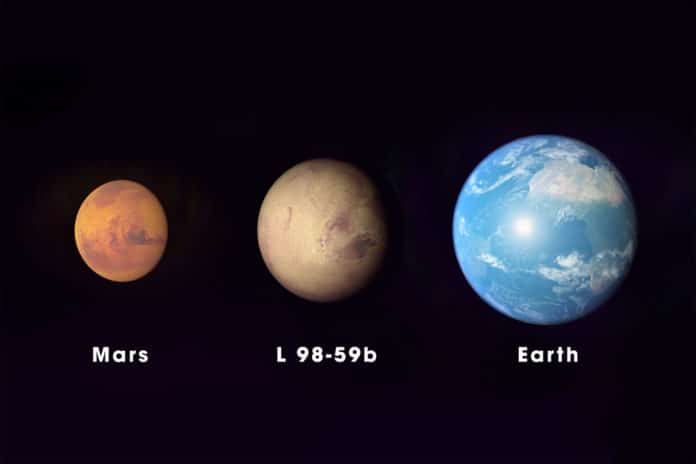NASA’s TESS (Transiting Exoplanet Survey Satellite) spacecraft is continuing to find exoplanets frequently since it began operations and now it has discovered its smallest exoplanet to date.
The newly discovered planet in the L 98-59 system – called L 98-59b – orbits a distant star along with two other planets dubbed L 98-59c and L 98-59d.
The planet L 98-59b is 80 percent the size of Earth and 10 percent smaller than the previous tiniest finding by TESS.

Credits: NASA
The system – L 98-59 – is an M dwarf star that is about 1/3 the mass of the Sun and is 35 light-years away from Earth in the constellation Volans. All the planets discovered so far – there are larger L 98-59c and L 98-59d – sit on the Venus zone, a range of stellar distances where a planet with an initial Earth-like atmosphere could experience a runaway greenhouse effect that transforms it into a Venus-like atmosphere.
L 98-59c and L 98-59d, are respectively around 1.4 and 1.6 larger than the Earth’s size. L 98-59b, the innermost world, orbits every 2.25 days and receives as much as 22 times the amount of energy Earth receives from the Sun. The middle planet, L 98-59c, orbits every 3.7 days and experiences about 11 times as much radiation as Earth. L 98-59d, the farthest planet orbits every 7.5 days and is blasted with around four times the radiant energy as Earth.
TESS has discovered all these three planets by using transits – regular dips in the star’s brightness caused by passing planets. It monitors a sector of the sky for 27 days at a time. The satellite completes its first year of studies in July and L 98-59 system will have appeared in seven of the 13 sectors that make up the southern sky. Scientists hope that it could be enough to both collect more detail about the known planets and possibly spot more.
While L 98-59b is a record for TESS, NASA’s Kepler mission has discovered an even smaller exoplanet named Kepler-37b that is only 20% larger than the Moon.
According to NASA, the TESS mission feeds our desire to understand where we came from and whether we’re alone in the universe. A paper on the findings was published in the Astronomical Journal.
